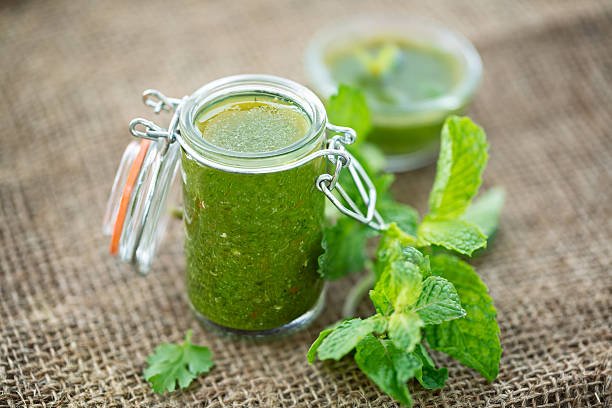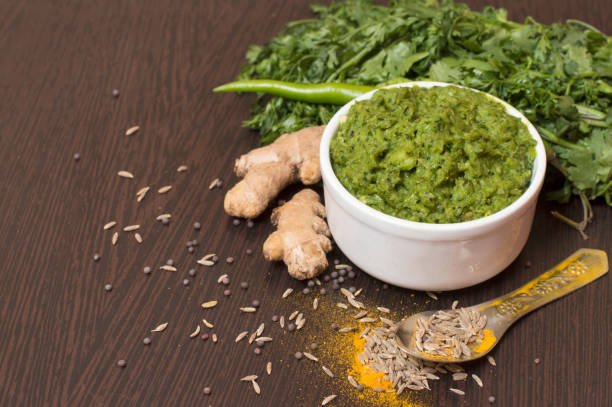When we think of Indian cuisine, it’s impossible to ignore the vibrant and tantalizing flavors that accompany every dish. From spicy curries to savory snacks, the Indian palate is incomplete without the wide array of condiments that enhance every bite. Among these, Pudina Ki Chutney—or Mint Chutney—holds a special place.

This bright green, aromatic, and tangy chutney is a staple in many Indian households. Whether served with samosas, kebabs, parathas, or chaats, pudina ki chutney is more than just a side dish—it’s an essential part of the Indian culinary experience.
In this blog post, we’ll take a deep dive into everything about pudina ki chutney: its origins, cultural importance, different styles of preparation, health benefits, and, of course, a foolproof recipe to make it at home.
Table of Contents
A Little History and Cultural Context
Chutneys in India have a long and storied history, dating back centuries. The word “chutney” is derived from the Hindi word chatni, meaning “to lick.” That’s precisely what these spicy, sweet, or tangy condiments make you want to do!
Mint, or pudina in Hindi, has been used in Indian cooking for ages—not only for its fresh flavor but also for its medicinal properties. In Ayurveda, mint is considered a cooling herb, useful for digestion and calming the system.
Pudina ki chutney is especially popular in North Indian cuisine but is cherished across the subcontinent with local variations. It’s often served as a fresh condiment with daily meals or at festive occasions, symbolizing a refreshing element on a spicy spread.

Why Pudina Ki Chutney is So Loved
Here’s why this chutney is a crowd favorite across India:
- Burst of Flavor: The chutney is typically made with mint, coriander, green chilies, garlic or ginger, lemon juice, and spices. The result is a flavor bomb—spicy, tangy, fresh, and slightly sweet if sugar or fruits like mango or pomegranate are added.
- Versatility: Pudina chutney pairs beautifully with snacks like pakoras, tikkas, kebabs, chaats, sandwiches, and dosas. It can also be a dip, a spread, or a marinade.
- Quick & Easy: With a blender and a few ingredients, pudina chutney can be whipped up in just 10–15 minutes.
- Healthy: It’s low in calories, fat-free, and rich in antioxidants, vitamins, and minerals.
Health Benefits of Mint Chutney
While it’s a flavor powerhouse, pudina chutney is also packed with nutrients:
- Aids Digestion: Mint is known for soothing the stomach and helping with digestion. The chutney often accompanies fried foods for this reason.
- Rich in Antioxidants: Mint, coriander, and lemon juice are full of antioxidants that help in detoxification.
- Boosts Immunity: Ingredients like garlic and ginger provide anti-inflammatory and antibacterial benefits.
- Hydrating & Cooling: Especially in the summer, mint chutney has a naturally cooling effect on the body.
- Low-Calorie: With minimal oil and sugar, it’s a light and guilt-free condiment.
Variations Across India
Like many Indian dishes, pudina ki chutney comes in several regional styles:
- North Indian Style: Made with fresh mint and coriander leaves, green chili, garlic or ginger, and lemon juice. Sometimes yogurt is added for a creamier texture.
- South Indian Style: Often includes coconut, tamarind, and roasted lentils like urad dal or chana dal, giving it a nutty depth.
- Bengali or Oriya Style: May incorporate mustard seeds and raw mango for extra pungency and tartness.
- Street Food Style: Very spicy, with extra tang from lemon juice or black salt (kala namak), and sometimes a pinch of sugar for balance.
- Fusion Versions: Some modern recipes include avocado for creaminess or pomegranate seeds for a sweet twist.
Ingredients for Classic Pudina Ki Chutney
Here’s a list of classic ingredients:
- Fresh Mint Leaves – 1 cup (washed and tightly packed)
- Fresh Coriander (Cilantro) – 1 cup (optional but balances mint flavor)
- Green Chilies – 1–2 (adjust to taste)
- Garlic Cloves – 2–3
- Ginger – 1/2 inch (peeled)
- Lemon Juice – 1–2 tablespoons
- Roasted Cumin Powder – 1/2 teaspoon
- Salt – to taste
- Sugar or Jaggery – 1/2 teaspoon (optional)
- Water – as needed for blending
Optional Additions:
- Yogurt – for creaminess
- Raw Mango – for extra tang
- Black Salt – for a chaat-style flavor
- Pomegranate Seeds (Anardana) – for a sweet-sour twist
How to Make Pudina Ki Chutney (Step-by-Step Recipe)
Step 1: Prep the Greens
Pluck the mint leaves from the stems and rinse them thoroughly in water. Do the same with coriander if using. Drain well.
Step 2: Blend the Ingredients
In a blender, add the mint, coriander, green chilies, garlic, ginger, cumin, lemon juice, and salt. Add a few tablespoons of water to help blend smoothly.
Step 3: Adjust Consistency
Add more water little by little until the chutney reaches a smooth, spoonable consistency. It should be thick enough to coat the back of a spoon.
Step 4: Taste and Balance
Taste the chutney and adjust salt, lemon juice, or spice as needed. You can add a bit of sugar to mellow the sharp flavors if desired.
Step 5: Store It Right
Transfer to a clean glass jar or container. It can be refrigerated for up to a week. For longer storage, freeze in ice cube trays and use as needed.
Tips for the Perfect Chutney
- Use Fresh Herbs: The flavor depends heavily on the freshness of mint and coriander. Avoid wilted or yellowing leaves.
- Balance is Key: Too much mint can make the chutney bitter. Coriander or a splash of lemon helps balance it out.
- Don’t Overblend: Overblending can make the chutney lose its bright green color. Use quick pulses.
- Acidity Matters: Lemon juice or raw mango is essential to prevent oxidation and add brightness.
Serving Ideas
Pudina ki chutney is endlessly versatile. Here are a few serving suggestions:
- Snacks: Serve with samosas, pakoras, spring rolls, or tikkis.
- Tandoori Dishes: An essential dip for kebabs, tandoori chicken, paneer tikka.
- Sandwich Spread: Use it in Bombay-style sandwiches or wraps.
- Rice & Curries: Add a spoonful to plain rice or dal for extra zing.
- Chaats & Street Food: Drizzle on bhel puri, sev puri, or dahi puri.
- Salad Dressing: Mix with yogurt or olive oil for a minty salad dressing.
Modern Twists on Pudina Ki Chutney
If you’re feeling experimental, here are some fun twists:
- Mint-Avocado Chutney: For a creamy, nutrient-rich version.
- Yogurt Mint Dip: Add thick yogurt and serve as a cooling dip.
- Sweet Mint Chutney: Add jaggery and tamarind for a sweet-sour combo.
Mint-Peanut Chutney: Add roasted peanuts for a nutty South Indian style chutney.
Conclusion: A Green Jar of Goodness
Pudina ki chutney is much more than a condiment—it’s a representation of India’s love for flavor, freshness, and balance. Whether served with an elaborate meal or a humble snack, this green chutney elevates any dish with its bright, zesty punch.
Easy to make and endlessly customizable, it’s a must-have in any Indian kitchen and a delightful addition to global cuisine.
So the next time you’re cooking Indian food or simply craving something zingy, whip up a batch of pudina ki chutney. One taste, and you’ll understand why it’s a timeless favorite.


